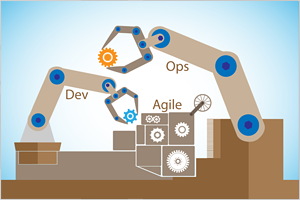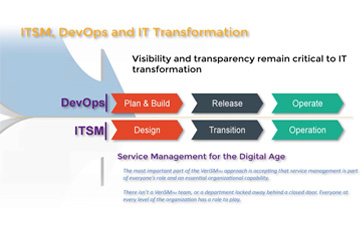DevOps
What is DevOps?
The term DevOps is a combination of the words “development” and “operations”. In practice, DevOps is a collaborative approach to the work that is performed by an enterprise’s IT operations staff and their application developers. Collaboration and communication between these two teams, who might otherwise function separately, are meant to increase the speed and quality of product or application releases.
DevOps philosophies, practices, and tools increase an organization’s ability to deliver applications and services at speed. The increased agility resulting from DevOps adoption enables organizations to better serve customers.
How does DevOps work?
Historically, development and operations teams have been silos. Communicating effectively across the teams has been a challenge and troubleshooting application issues has also been a manual and time-consuming process. DevOps aims to address these challenges.
In the broadest sense, the DevOps philosophy embraces collaborative effort rather than siloed work. In practice, DevOps engineering is an iterative approach to software development, deployment, and maintenance. Development and operations team members work together throughout the software lifecycle, from initial development to test to deployment to operations.
DevOps automates processes that historically have been manual and slow. The technology stack and tooling are intended to automate different parts of the software lifecycle and helps increase the speed of software delivery and deployment.
DevOps Practices
DevOps isn’t just a way of thinking about your work – there are specific procedures you can implement. This methodology typically relies on the following:
- Configuration management: In this practice, developers use code to automate system configuration and ongoing operational tasks. Configuration changes can be standardized, freeing up developers and administrators who would typically have to manually configure software or operating systems at an organization.
- Microservices: A microservices architecture uses a lightweight, well-defined interface to run a set of small services that can function independently or as a group. This approach to application development makes it easier to innovate quickly and adjust to different needs.
- Monitoring: Ongoing monitoring of logs and metrics can help DevOps teams understand how individual applications affect overall system performance and the end-user experience.
- Continuous integration and continuous delivery (CI/CD): These software development practices help teams deliver reliable solutions quickly. Continuous integration is the practice of merging code changes into a central repository to improve software quality and speed up software update releases. Continuous delivery means that code changes are deployed into a testing environment after the build phase, ensuring they’re ready for release as quickly as possible.
Benefits of DevOps
Cross-functional collaboration means that work gets done more efficiently and effectively. The benefits of DevOps include:
- Better collaboration: DevOps culture relies on shared responsibility, feedback, and teamwork. Looking at systems holistically, DevOps aims to break down barriers between development and operations teams.
- Speed: Using a DevOps model speeds up the feedback loop, ensuring less downtime and faster incident resolution. Furthermore, teams that practice DevOps can release deliverables faster and with more frequency.
- Improved triaging system: Every team faces unplanned work eventually. With a clear process in place for priorities and how issues are addressed, DevOps teams can do a better job of anticipating and delegating unforeseen projects.
Regardless of their organizational hierarchy, companies that use a DevOps philosophy create a sense of shared responsibility for product development and success.
Implementing a DevOps model
At eG Innovations, our team has over two decades of experience in providing customized solutions for IT performance monitoring. With support for 200+ technologies, we can help your operations staff and developers ensure that end users have an optimal experience.
Many organizations are now adopting APM (Application Performance Monitoring) for DevOps. You can read more about this approach, the practicalities of this type of implementation and how it can increase application quality beyond performance improvements in: Benefits of APM for DevOps - IT Glossary | eG Innovations.
Whether you were an early adopter of DevOps methodology or are just beginning to shift your team culture, eG Innovations can help you with performance improvement. For more information about our products and solutions, contact us today.




